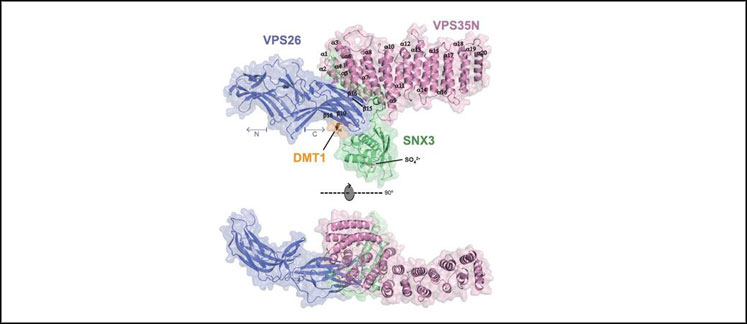In this research, carried out by CIC bioGUNE researchers in collaboration with the National Institutes of Health (NIH) Agency of the United States, it is described a recognition mechanism for reusing the divalent metal transporter protein (DMT1) involved in cellular absorption of iron, thereby saving energy and consumption of resources.
Retromer is a complex of proteins responsible for recycling protein channels and receptors involved in a wide range of physiological processes. However, the mechanism for selecting which proteins are to be recycled and their inclusion in vesicles for transportation has remained elusive throughout more than 15 years. This work explains the selection mechanism, revealing how coordination between the retromer and SNX3, another cargo protein, promotes the formation of a cavity which, in turn, provides an entry point for the consensus motif present in the protein to be recycled.

Fig. Overall Structure of the VPS26-VPS35N-SNX3-DMT1-II Complex. The crystal structure is shown in two orthogonal views represented by a ribbon diagram with transparent surface.
3D structure of retromer at detailed atomic level
For solving the three-dimensional structure of retromer at the atomic level X-ray crystallography has been used. The data was obtained at different synchrotron facilities: ALBA Synchrotron (at the macromolecular crystallography beamline, XALOC), Diamond Light Source (103 and 102) from United Kingdom and SOLEIL Synchrotron (Proxima1) and the European Synchrotron Radiation Facility, both from France.
This information offers a great advantage to the research group, when looking for compounds which stabilize retromer and which may be patented and assessed as drugs against pathologies such as Alzheimer and Parkinson.
Reference: "Structural mechanism for Cargo Recognition by the Retromer Complex" María Lucas, David C. Gershlick, Ander Vidaurrazaga, Adriana L. Rojas, Juan S. Bonifacino. Aitor Hierro. Cell 167 (6) (2016) 1623-1635, doi:10.1016/j.cell.2016.10.056




